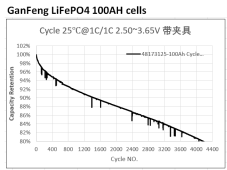FilterGuy
Solar Engineering Consultant - EG4 and Consumers
Here is an interesting chart on Cycle Life:

Look at the charge and discharge rate. 1C for both and they still lasted over 4000 cycles before they hit 80%. In a typical solar installation, the charge and discharge rate won't be anywhere near that high. I can easily imagine a cycle life of 8000 or more in a solar application. 8000/365=22 years....and that assumes a full cycle every day!!
I believe SOK and EG4 use these cells. I am not sure who else uses them.

Look at the charge and discharge rate. 1C for both and they still lasted over 4000 cycles before they hit 80%. In a typical solar installation, the charge and discharge rate won't be anywhere near that high. I can easily imagine a cycle life of 8000 or more in a solar application. 8000/365=22 years....and that assumes a full cycle every day!!
I believe SOK and EG4 use these cells. I am not sure who else uses them.


